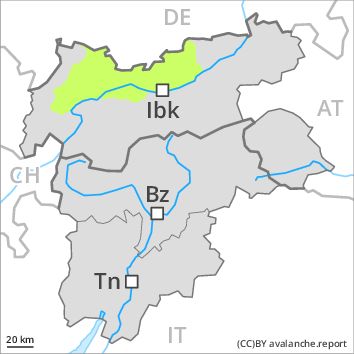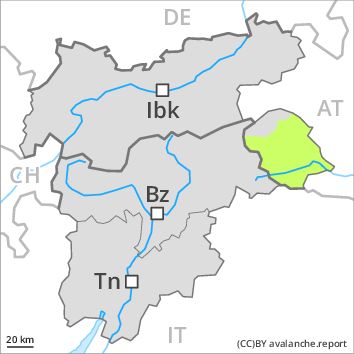Regions
Weißkugel Range, Western Verwall Mountains, Gurgler Range, Central Stubai Alps, Eastern Verwall Mountains, Northern Zillertal Alps, Allgäu Alps, Silvretta, Venediger Range, Samnaun Mountains, Northern Oetz and Stubai Alps, Western Tuxer Alps, Eastern Tuxer Alps, Western Lechtal Alps, Glockturm Range

Danger level
Danger Level 2 - Moderate above the treeline
Danger Level 1 - Low above the treeline
Avalanche Problem
Wind-drifted snow above the treeline, N-NE-E-SE-S-SW-W-NW

Fresh wind slabs above the tree line.
As the day progresses as a consequence of fresh snow and strong wind there will be only a slight increase in the avalanche danger. The fresh wind slabs are to be evaluated with care and prudence in all aspects at high altitudes and in high Alpine regions, in particular adjacent to ridgelines and in gullies and bowls. The number and size of avalanche prone locations will increase with altitude. Avalanches can be released, even by a single winter sport participant and reach medium size.
Apart from the danger of being buried, restraint should be exercised as well in view of the danger of avalanches sweeping people along and giving rise to falls.
Snowpack
dp 6: cold, loose snow and wind
In some regions 5 cm of snow. will fall above approximately 1200 m. The sometimes storm force wind will transport the fresh and old snow. As the day progresses the wind slabs will increase in size additionally. In some cases wind slabs are lying on soft layers. This applies especially on shady slopes.
Tendency
Gradual increase in avalanche danger as a consequence of the fresh snow.
Regions
Brandenberg Alps, Western Kitzbühel Alps, Wilder Kaiser Mountains - Waidring Alps, Eastern Kitzbühel Alps

Danger level
Danger Level 1 - Low
Avalanche Problem
Favourable situation

The conditions are favourable.
Only a little snow is lying. Adjacent to ridgelines small wind slabs will form. They are rather rare and are clearly recognisable to the trained eye.
Snowpack
No distinct weak layers exist in the snowpack in all altitude zones. The snowpack will be stable over a wide area. As a consequence of a strengthening westerly wind, small wind slabs will form as the day progresses in particular adjacent to ridgelines. At low and intermediate altitudes hardly any snow is lying.
Tendency
Slight increase in avalanche danger as a consequence of the snowfall.
Regions
Karwendel Mountains, Central Lechtal Alps, Grieskogel Mountains, Eastern Lechtal Alps - Ammergau Alps, Mieming Mountains

Danger level
Danger Level 1 - Low
Avalanche Problem
Wind-drifted snow above 2400m, N-NE-E-NW

A mostly favourable avalanche situation will be encountered over a wide area. Fresh wind slabs require caution.
The fresh wind slabs are in some cases prone to triggering in particular on northwest to north to east facing aspects above approximately 2400 m, in particular adjacent to ridgelines. They are clearly recognisable to the trained eye. Skiers can release avalanches in some places. These are rather small. Apart from the danger of being buried, restraint should be exercised as well in view of the danger of avalanches sweeping people along and giving rise to falls.
Snowpack
dp 6: cold, loose snow and wind
The old snowpack will be generally well bonded. As a consequence of a strong to storm force westerly wind, further wind slabs will form as the day progresses in particular adjacent to ridgelines. In some cases wind slabs are lying on soft layers. The wind slabs are small but prone to triggering.
Tendency
Gradual increase in avalanche danger as a consequence of the snowfall.
Regions
Glockner Range, Eastern Deferegger Alps, Schober Mountains, Lienzer Dolomites, Eastern Rieserferner Mountains

Danger level
Danger Level 1 - Low
Avalanche Problem
Wind-drifted snow above 2400m, N-NE-NW

Fresh wind slabs require caution.
In particular above approximately 2400 m the wind slabs will increase in size moderately as the day progresses. They are clearly recognisable to the trained eye. Skiers can release avalanches as before. These are rather small. Apart from the danger of being buried, restraint should be exercised as well in view of the danger of avalanches sweeping people along and giving rise to falls. In addition a latent danger of gliding avalanches exists. This applies on steep grassy slopes below approximately 2600 m.
Snowpack
dp 6: cold, loose snow and wind
The old snowpack will be generally well bonded. The fresh wind slabs remain in some cases prone to triggering. This applies on very steep shady slopes at high altitudes and in high Alpine regions.
Tendency
The avalanche danger will persist.




